Consequences of Spatial Heterogeneity of Forest Landscape on Ecosystem Water Conservation Service in the Yi River Watershed in Central China
Abstract
1. Introduction
2. Materials and Methods
2.1. Site Description
2.2. Data Resources
2.3. Methods
2.3.1. Quantifying an Ecosystem Water Conservation Service
2.3.2. Analyzing Landscape Spatial Heterogeneity
2.3.3. Statistical Analysis
3. Results and Discussion
3.1. Spatial Distribution of the Water Conservation Service
3.2. Variations of Spatial Heterogeneity in Forest Landscape
3.2.1. Landscape Compositional Heterogeneity
3.2.2. Landscape Configurational Heterogeneity
3.3. Correlation between Forest Landscape Spatial Heterogeneity and the Ecosystem Water Conservation Service
3.4. The Influencing Strength of Forest Landscape Spatial Heterogeneity on the Water Conservation Service
4. Conclusions
Author Contributions
Funding
Conflicts of Interest
References
- Bai, J.; Peng, D.; Yu, X.; Zheng, X. Research advances in forest landscape ecology. Chin. J. Ecol. 2005, 24, 943–947. [Google Scholar]
- Guo, J.; Zhang, Y. Advances and perspective of forest landscape ecology in China. World For. Res. 2003, 16, 46–49. [Google Scholar]
- Tiemann, A.; Ring, I. Challenges and opportunities of aligning forest function mapping and ecosystem service concept in Germany. Forests 2018, 9, 691. [Google Scholar] [CrossRef]
- Caputo, J.; Butler, B. Ecosystem service supply and capacity on U.S. family forestlands. Forests 2017, 8, 395. [Google Scholar] [CrossRef]
- Williams, K.; Biedenweg, K.; Cerveny, L. Understanding ecosystem service preferences across residential classifications near Mt. Baker Snoqualmie National Forest, Washington (USA). Forests 2017, 8, 157. [Google Scholar] [CrossRef]
- Millenium Ecosystem Assessment. Ecosystems and Human Well-Being: Synthesis; Island Press: Washington, DC, USA, 2005. [Google Scholar]
- Gong, S.; Xiao, Y.; Xiao, Y.; Zhang, L.; Ouyang, Z. Driving forces and their effects on water conservation services in forest ecosystems in China. Chin. Geogr. Sci. 2017, 27, 216–228. [Google Scholar] [CrossRef]
- Gong, S.; Xiao, Y.; Zheng, H.; Xiao, Y.; Ouyang, Z. Spatial patterns of ecosystem water conservation in China and its impact factors analysis. Acta Ecol. Sin. 2017, 37, 2455–2462. [Google Scholar]
- Liu, L.; Bian, Z.; Ding, S. Effects of landscape spatial heterogeneity on the generation and provision of ecosystem services. Acta Ecol. Sin. 2018, 38, 6412–6421. [Google Scholar]
- Anderssona, E.; McPhearson, T.; Kremer, P.; Gomez-Baggethun, E.; Haase, D.; Tuvendal, M.; Wurster, D. Scale and context dependence of ecosystem service providing units. Ecosyst. Serv. 2015, 12, 157–164. [Google Scholar] [CrossRef]
- Blumstein, M.; Thompson, J.R. Land-use impacts on the quantity and configuration of ecosystem service provisioning in Massachusetts, USA. J. Appl. Ecol. 2015, 52, 1009–1019. [Google Scholar] [CrossRef]
- Liu, L.; Liu, H.; Ren, J.; Bian, Z.; Ding, S. Research progress on the mechanism of ecosystem services generation. Chin. J. Appl. Ecol. 2017, 28, 2731–2738. [Google Scholar]
- Roces-Díaz, J.V.; Vayreda, J.; Banqué-Casanovas, M.; Díaz-Varela, E.; Bonet, J.A.; Brotons, L.; de-Miguel, S.; Herrando, S.; Martínez-Vilaltaah, J. The spatial level of analysis affects the patterns of forest ecosystem services supply and their relationships. Sci. Total Environ. 2018, 626, 1270–1283. [Google Scholar] [CrossRef] [PubMed]
- Qiu, J.X.; Turner, M.G. Importance of landscape heterogeneity in sustaining hydrologic ecosystem services in an agricultural watershed. Ecosphere 2015, 6, 1–19. [Google Scholar] [CrossRef]
- Turner, M.G.; Donato, D.C.; Romme, W.H. Consequences of spatial heterogeneity for ecosystem services in changing forest landscapes: Priorities for future research. Landsc. Ecol. 2013, 28, 1081–1097. [Google Scholar] [CrossRef]
- Yang, J.P.; Ding, Y.J.; Chen, R.S.; Liu, L.Y. Variations of precipitation and evaporation in north China in recent 40 years. J. Arid Land Resour. Environ. 2003, 17, 6–11. [Google Scholar]
- Wang, W.T.; Qian, L.X. Spatial distribution and seasonal variation of evapotranspiration in Yiluo River basin based on MODIS data. Resour. Sci. 2012, 34, 1582–1590. [Google Scholar]
- Wang, W.T.; Wang, J.L.; Du, J. Land surface evaporation estimation of Yiluo River basin based on fusion of ETM+ and MODIS data. Geogr. Res. 2013, 32, 817–821. [Google Scholar]
- Chen, L.D.; Fu, B.J.; Zhao, W.W. Source-sink landscape theory and its ecological significance. Acta Ecol. Sin. 2006, 26, 1444–1449. [Google Scholar] [CrossRef]
- Li, C.; Wang, J.; Hu, L.; Yu, L.; Clinton, N.; Huang, H.; Yang, J.; Gong, P. A circa 2010 thirty meter resolution forest map of China. Remote Sens. 2014, 6, 5325–5343. [Google Scholar] [CrossRef]
- Hou, X.; Sun, W.; Li, J.; Li, Q. The progress of research and forecast on the quantification of the forest water conservation capacity. J. Arid Land Resour. Environ. 2018, 32, 121–127. [Google Scholar]
- Zhang, B.; Li, W.; Xie, G.; Xiao, Y. Water conservation function and its measurement methods of forest ecosystem. Chin. J. Ecol. 2009, 28, 529–534. [Google Scholar]
- Tian, Y.; Li, M.; Wu, B. The land use dynamics simulation and water conservation service capacity estimates in Beibu Gulf Coastal—A case study in Qinzhou City of Guangxi Zhuang Autonomous region. Yunnan Geogr. Environ. Res. 2013, 25, 69–78. [Google Scholar]
- Xie, G.; Lu, C.; Leng, Y.; Zheng, D.; Li, S. Ecological assets valuation of the Tibetan Plateau. J. Nat. Resour. 2003, 18, 189–196. [Google Scholar]
- Gustafson, E.J. Quantifying landscape spatial pattern: What is the state of the art? Ecosystems 1998, 1, 143–156. [Google Scholar] [CrossRef]
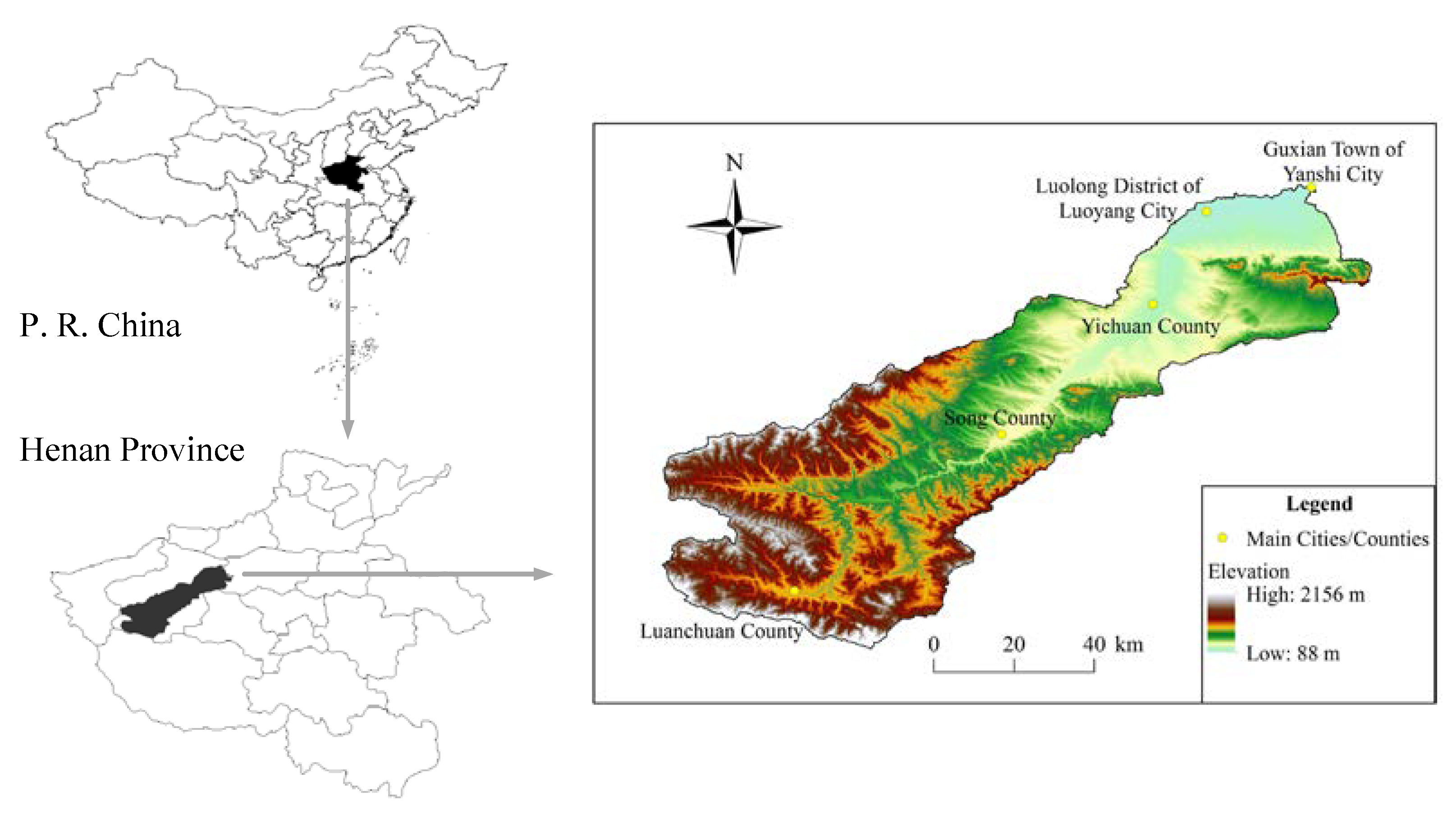
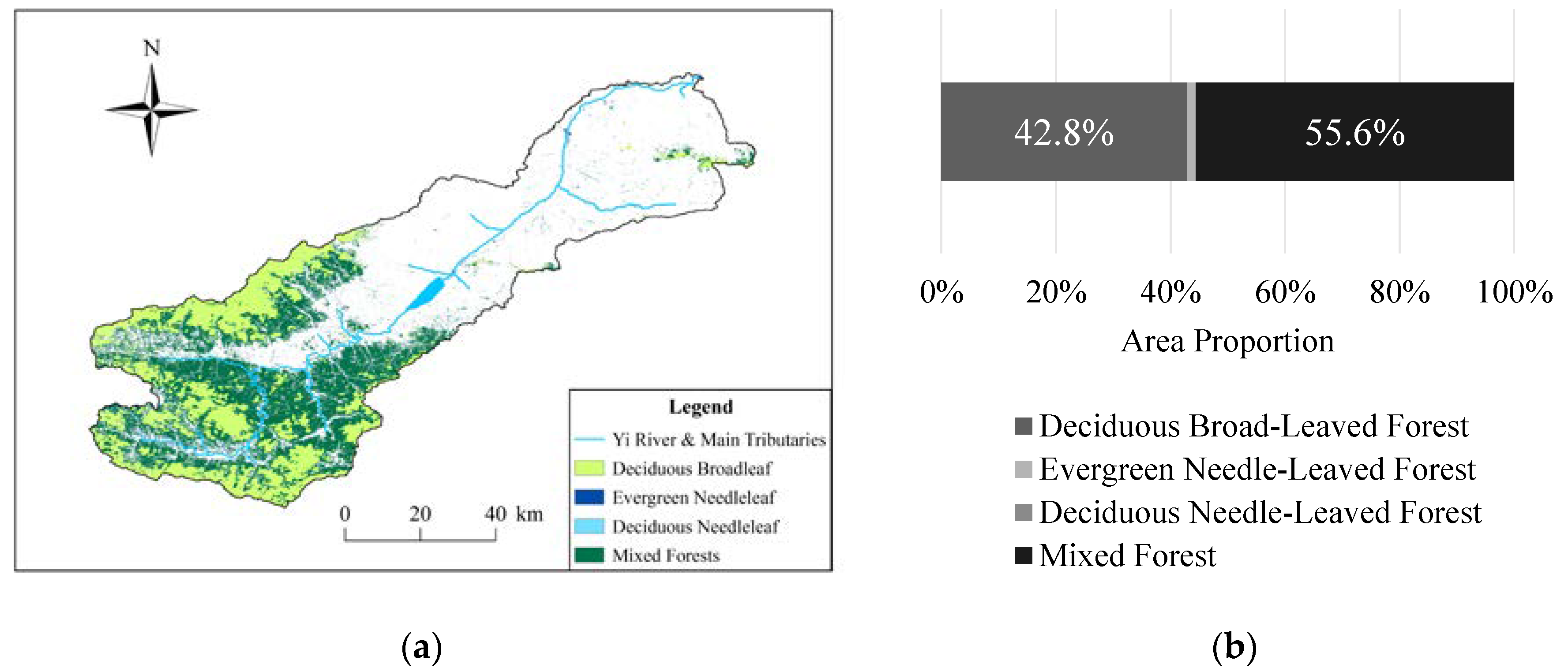
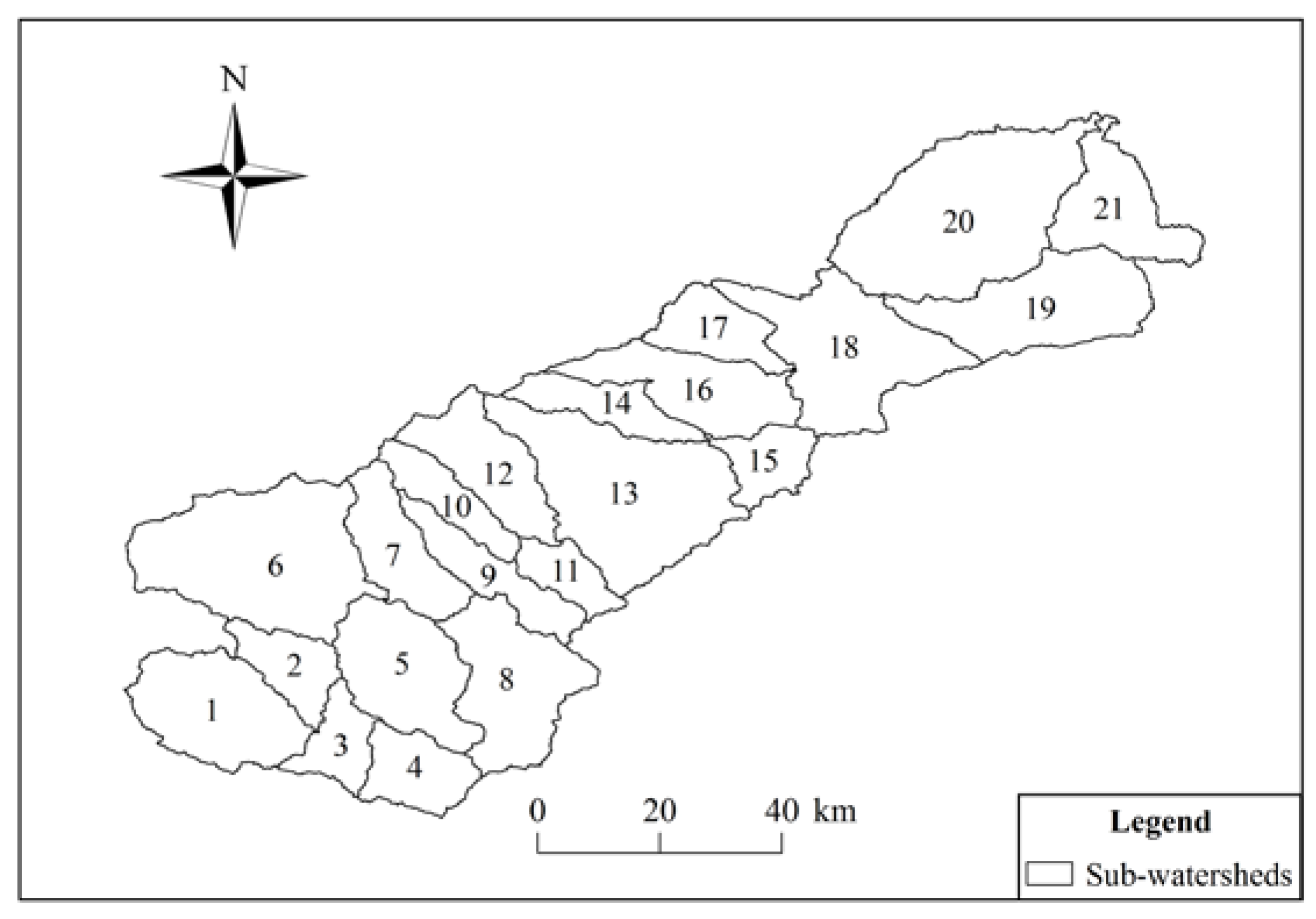

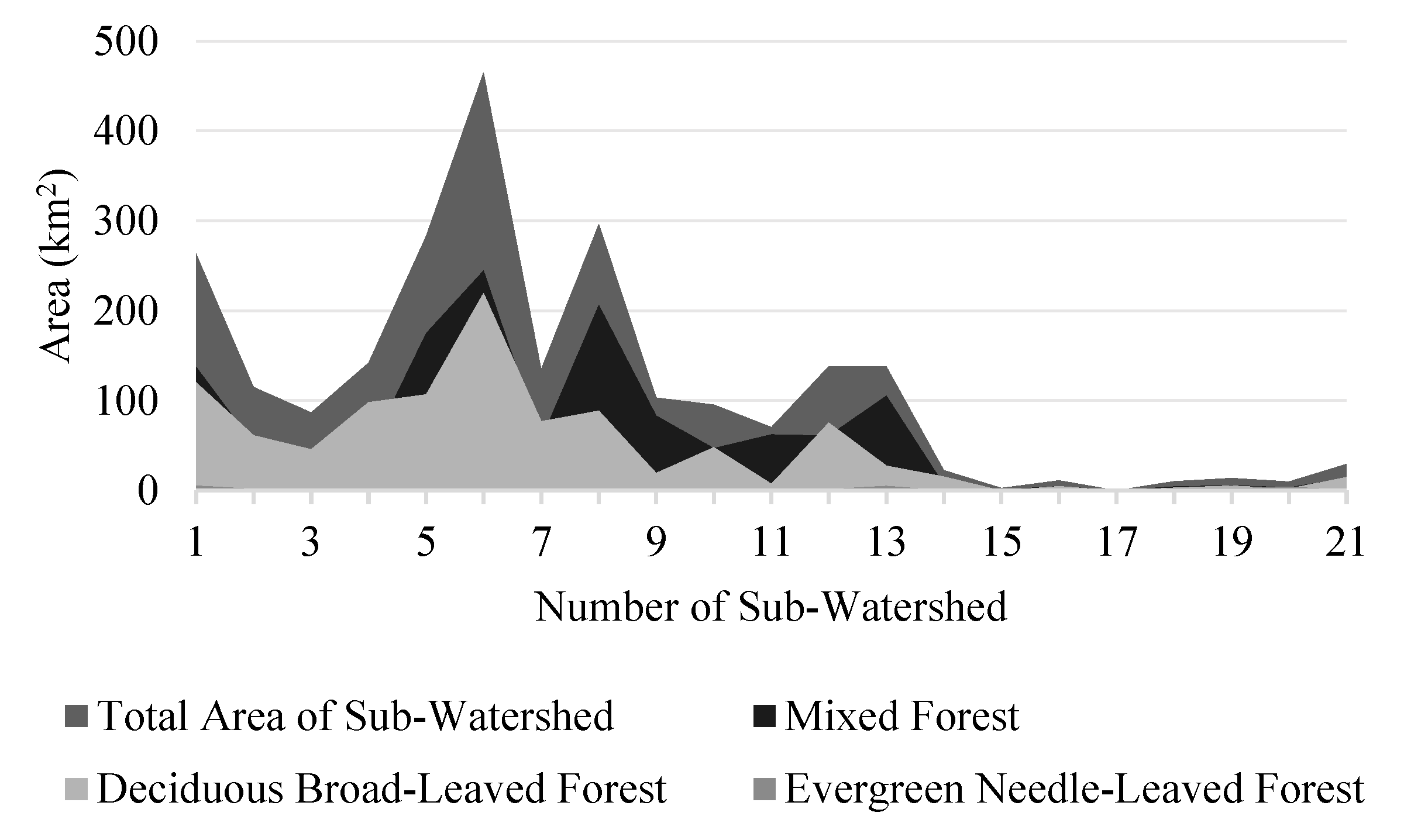
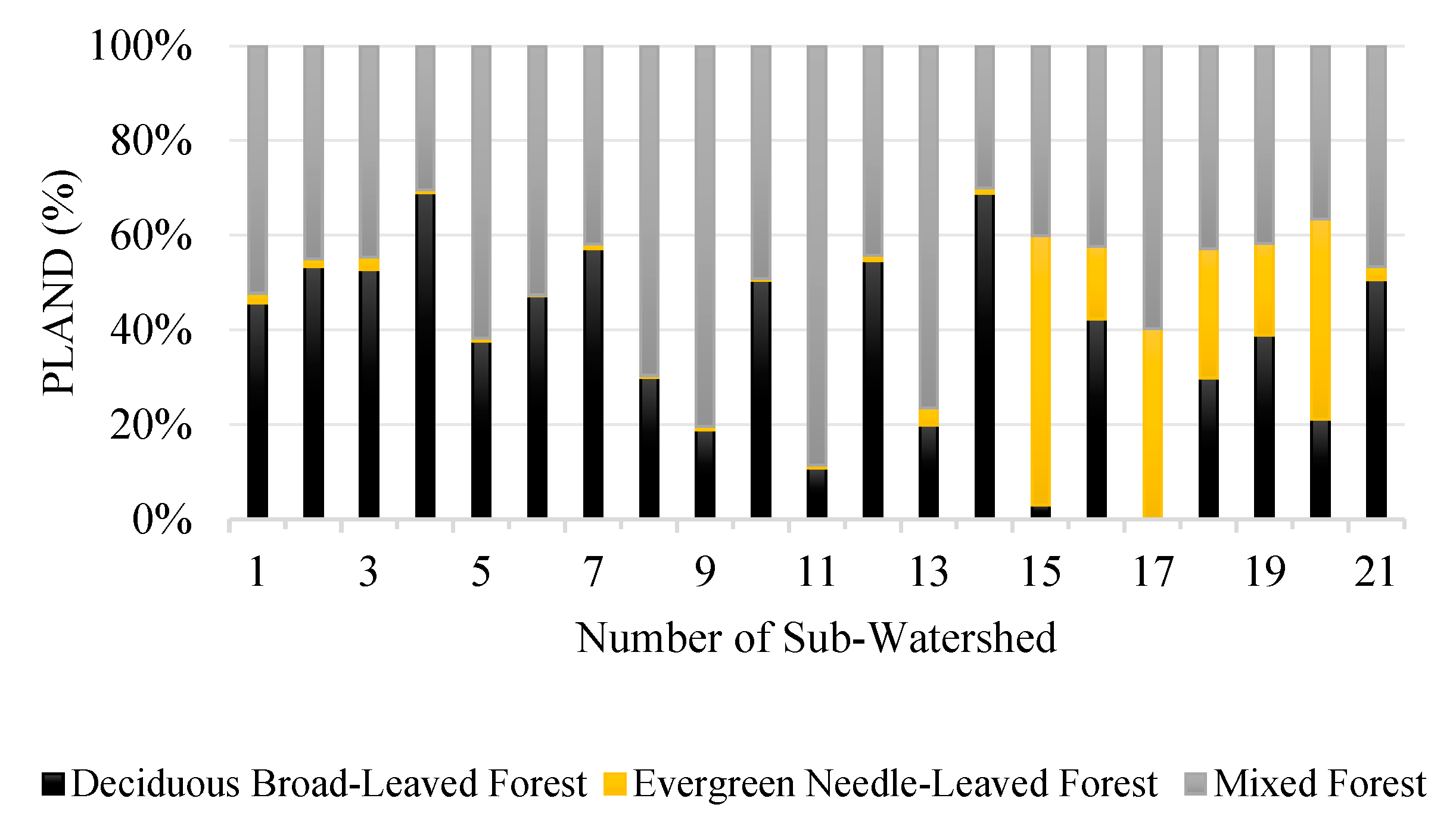
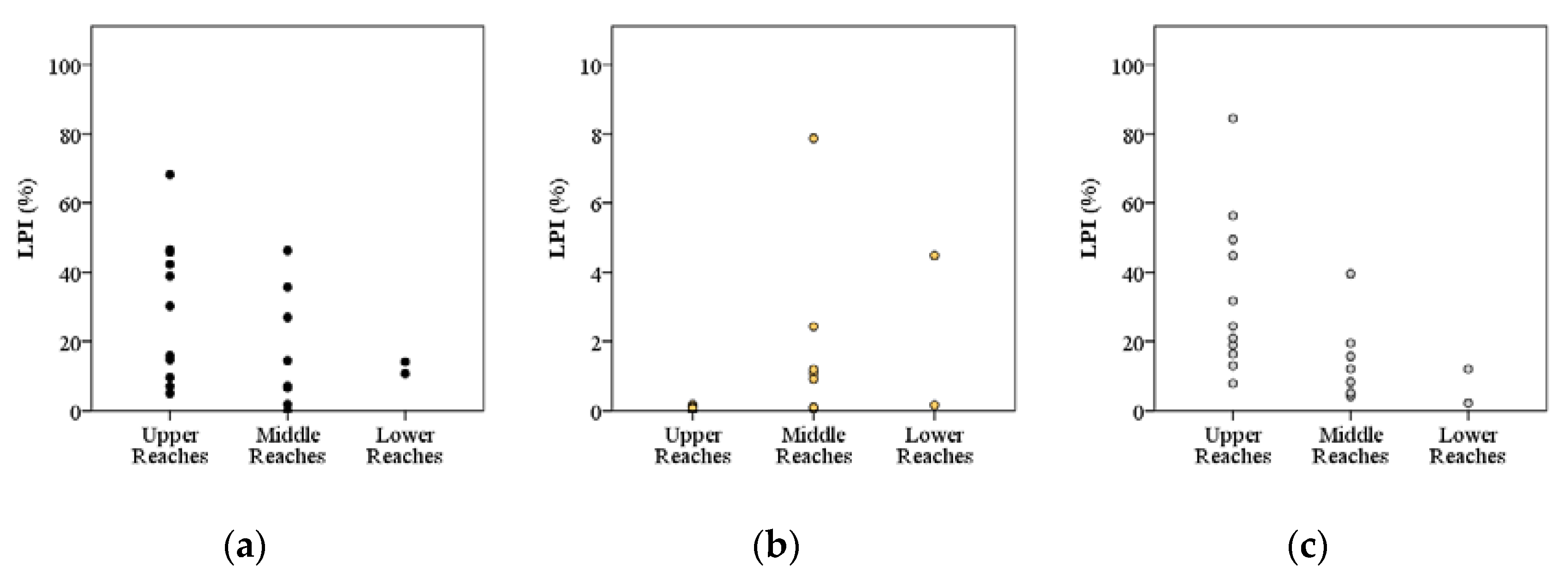
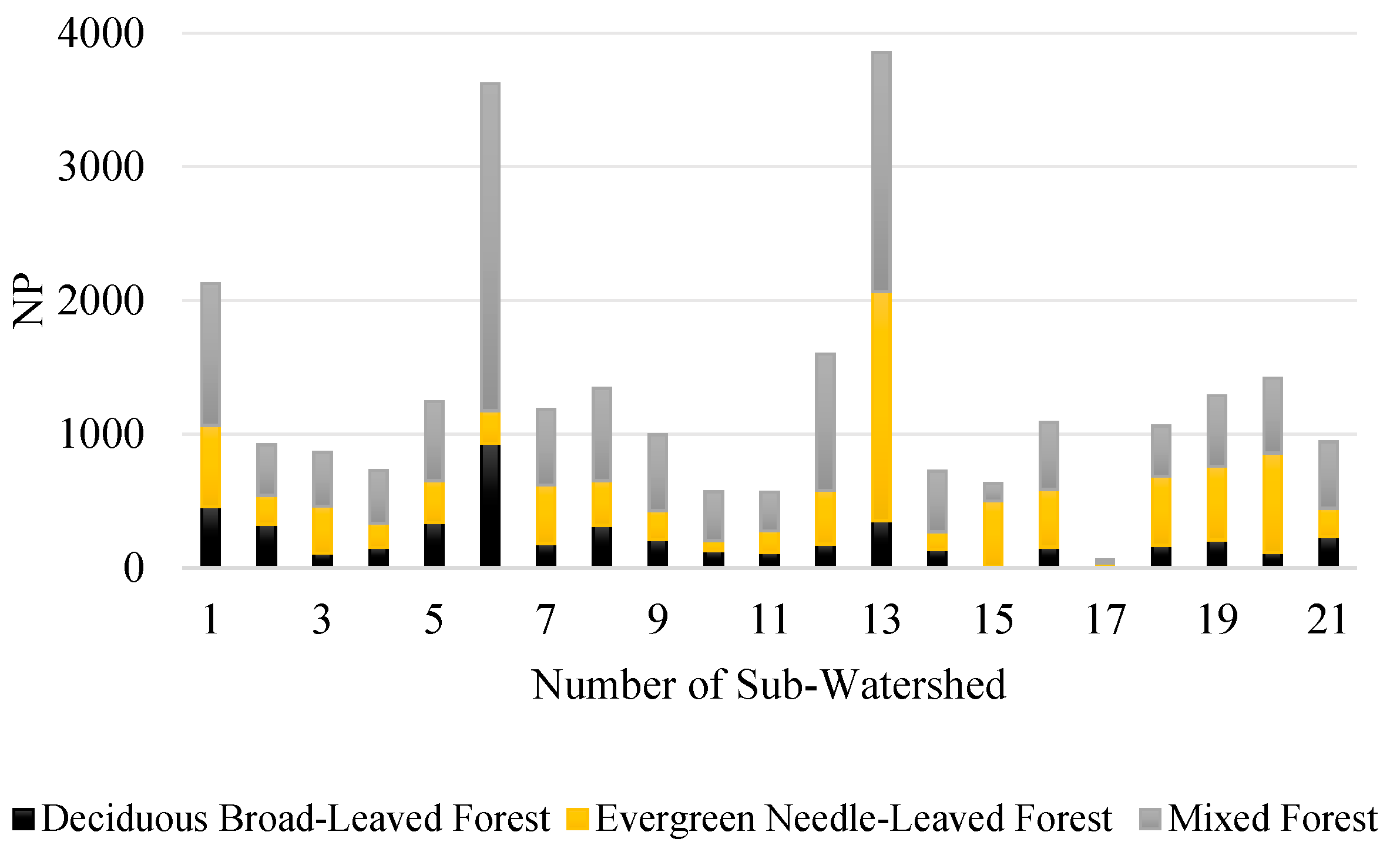
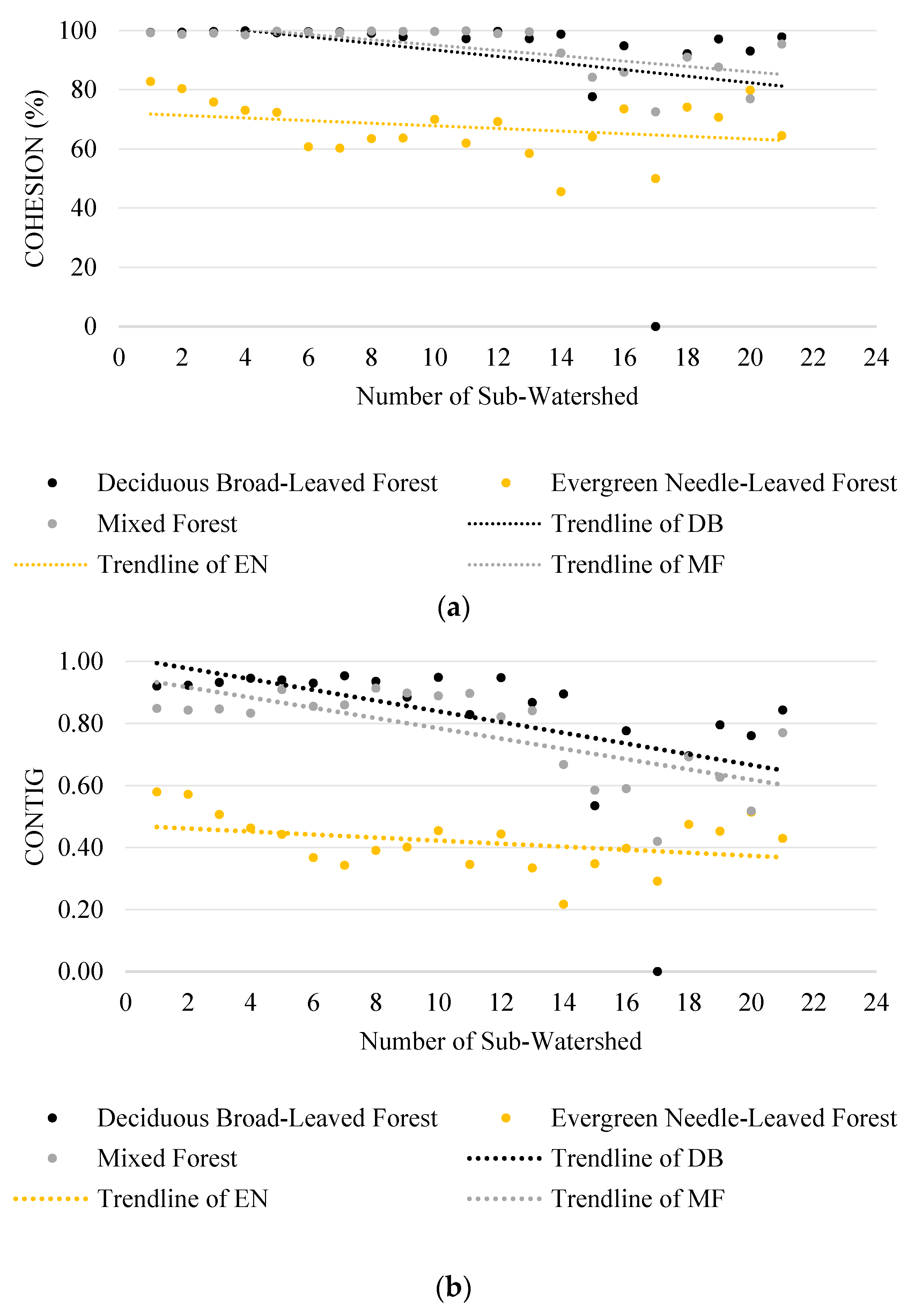
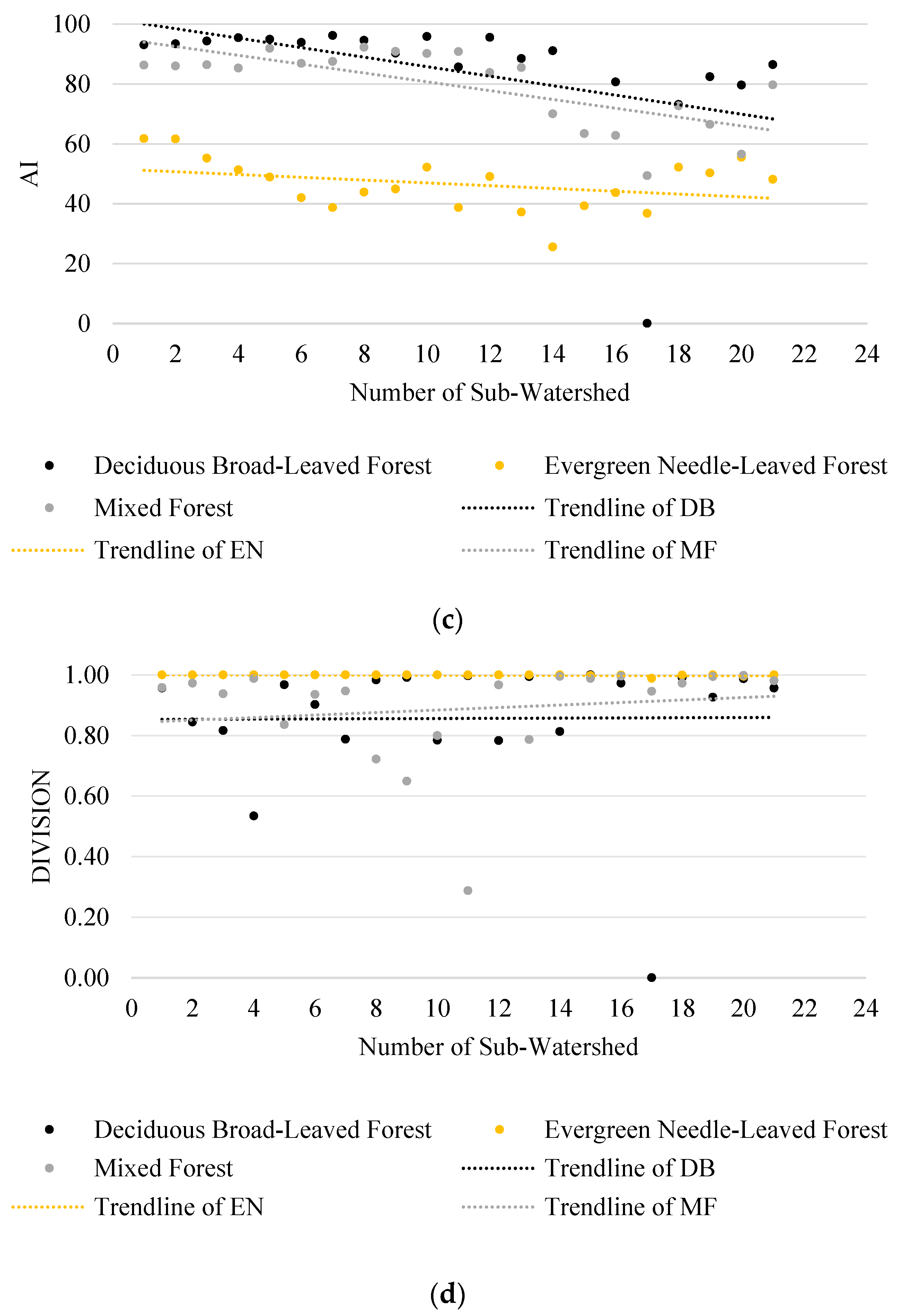
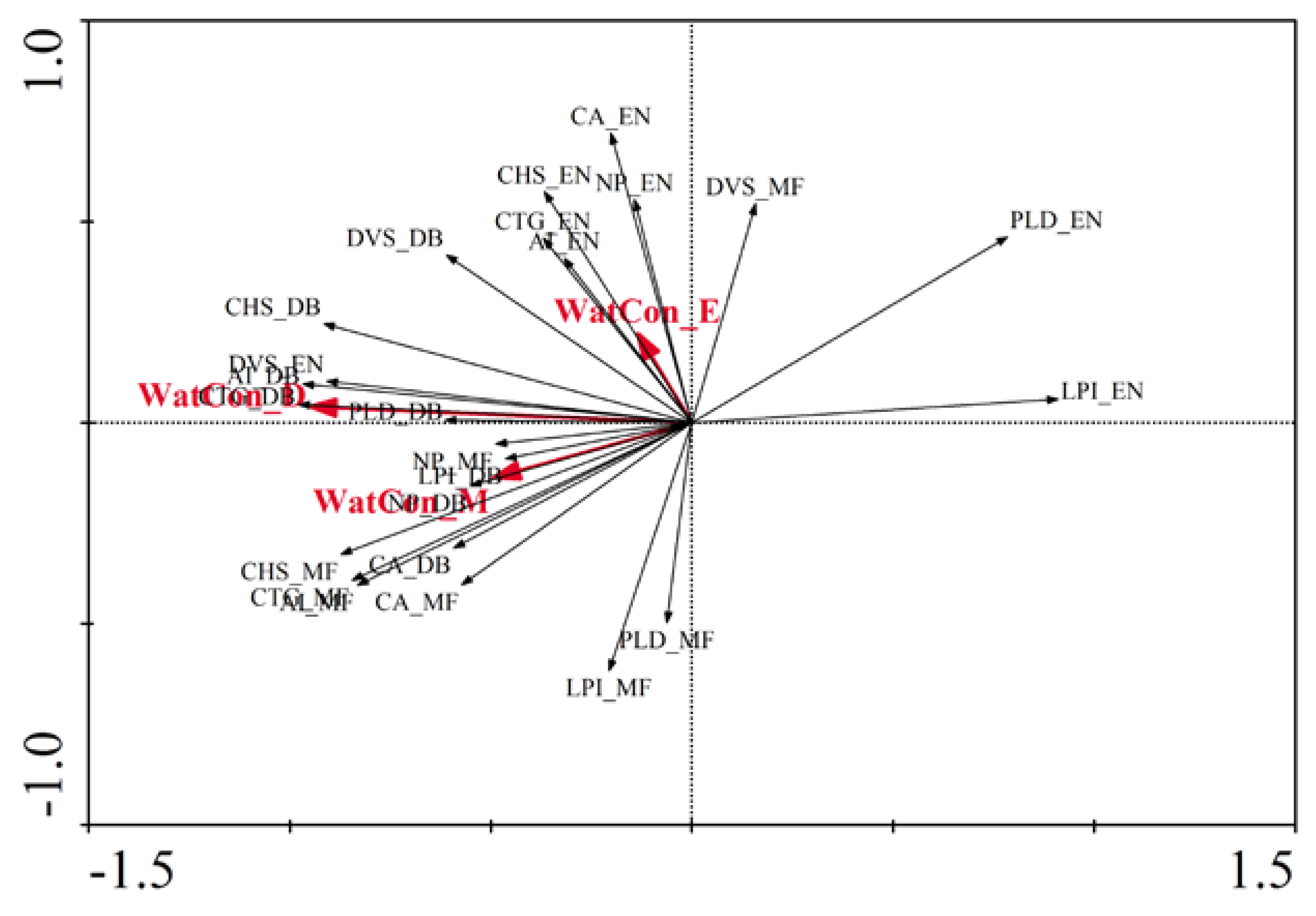
| Types of Forest | Total Area (hm2) | Annual Average Precipitation (mm) | Runoff Coefficient | Water Conservation Amount (m³) |
|---|---|---|---|---|
| Deciduous Broad-Leaved Forest | 104,200.78 | 156.30 | 2.70 | 4.40 × 107 |
| Evergreen Needle-Leaved Forest | 3791.68 | 5.69 | 4.52 | 9.75 × 104 |
| Deciduous Needle-Leaved Forest | 0.27 | 0.0004 | 0.88 | 9.50 × 10–5 |
| Mixed Forest | 135,193.36 | 202.79 | 3.52 | 9.65 × 107 |
| Landscape Metrics | Calculating Formulas | Description |
|---|---|---|
| CA | A measure of landscape composition. To reflect how much of the landscape is comprised of a particular patch type. | |
| PLAND | To quantify the proportional abundance of each patch type in the landscape. | |
| LPI | A simple measure of dominance. To quantify the percentage of total landscape area comprised by the largest patch at the class level. | |
| NP | The total number of patches of a certain landscape composition type. To reflect landscape spatial pattern and describe the heterogeneity. | |
| CONTIG | A measure to assess the spatial connectedness or contiguity of cells within a grid-cell patch and provide an index on patch boundary configuration and, thus, patch shape. | |
| COHESION | A measure that can assess the physical connectedness of patches in the same landscape composition type and describe the connectivity among patches. | |
| AI | To show the frequency with which different pairs of patch types appear side by side on the map. | |
| DIVISION | A measure to reflect the spatial pattern of the landscape, which is based on the cumulative patch area distribution and is interpreted as the probability that two randomly chosen pixels in the landscape are not situated in the same patch of the corresponding patch type. |
| Deciduous Broad-Leaved | Evergreen Needle-Leaved | Mixed Forest | |||||||
|---|---|---|---|---|---|---|---|---|---|
| CA | PLAND | LPI | CA | PLAND | LPI | CA | PLAND | LPI | |
| Correlation Coefficient | 0.931 ** | 0.313 | 0.353 | 0.065 | −0.762 ** | −0.873 ** | 0.962 ** | 0.470 * | 0.529 * |
| Significance | 0.000 | 0.167 | 0.116 | 0.780 | 0.000 | 0.000 | 0.000 | 0.032 | 0.014 |
| NP | CONTIG | COHESION | AI | DIVISION | |
|---|---|---|---|---|---|
| Correlation Coefficient | 0.768 ** | 0.751 ** | 0.686 ** | 0.751 ** | −0.077 |
| Significance | 0.000 | 0.000 | 0.001 | 0.000 | 0.741 |
| NP | CONTIG | COHESION | AI | DIVISION | |
|---|---|---|---|---|---|
| Correlation Coefficient | 0.034 | 0.032 | −0.087 | 0.048 | 0.796 ** |
| Significance | 0.884 | 0.889 | 0.708 | 0.836 | 0.000 |
| NP | CONTIG | COHESION | AI | DIVISION | |
|---|---|---|---|---|---|
| Correlation Coefficient | 0.739 ** | 0.791 ** | 0.795 ** | 0.775 ** | −0.559 ** |
| Significance | 0.000 | 0.000 | 0.000 | 0.000 | 0.008 |
| Axis. | Eigenvalue | Correlation Coefficient | Contribution to Water Conservation (%) | Accumulating Contribution to Water Conservation and Variation in Landscape Metrics (%) |
|---|---|---|---|---|
| 1 | 0.916 | 1.00 | 91.6 | 91.6 |
| 2 | 0.055 | 1.00 | 97.1 | 97.1 |
| 3 | 0.029 | 1.00 | 100.0 | 100.0 |
| 4 | 0.000 | 0.00 | 0.0 | 0.0 |
© 2020 by the authors. Licensee MDPI, Basel, Switzerland. This article is an open access article distributed under the terms and conditions of the Creative Commons Attribution (CC BY) license (http://creativecommons.org/licenses/by/4.0/).
Share and Cite
Liu, L.; Bian, Z.; Ding, S. Consequences of Spatial Heterogeneity of Forest Landscape on Ecosystem Water Conservation Service in the Yi River Watershed in Central China. Sustainability 2020, 12, 1170. https://doi.org/10.3390/su12031170
Liu L, Bian Z, Ding S. Consequences of Spatial Heterogeneity of Forest Landscape on Ecosystem Water Conservation Service in the Yi River Watershed in Central China. Sustainability. 2020; 12(3):1170. https://doi.org/10.3390/su12031170
Chicago/Turabian StyleLiu, Lyuyi, Ziqi Bian, and Shengyan Ding. 2020. "Consequences of Spatial Heterogeneity of Forest Landscape on Ecosystem Water Conservation Service in the Yi River Watershed in Central China" Sustainability 12, no. 3: 1170. https://doi.org/10.3390/su12031170
APA StyleLiu, L., Bian, Z., & Ding, S. (2020). Consequences of Spatial Heterogeneity of Forest Landscape on Ecosystem Water Conservation Service in the Yi River Watershed in Central China. Sustainability, 12(3), 1170. https://doi.org/10.3390/su12031170





